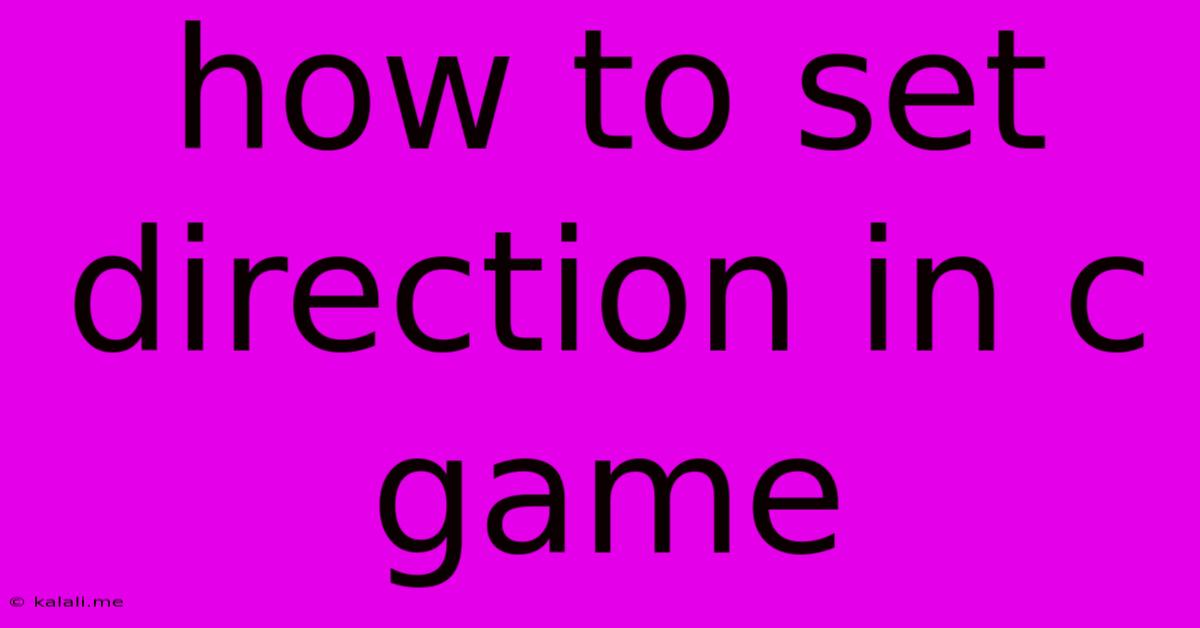How To Set Direction In C Game
Kalali
May 29, 2025 · 3 min read

Table of Contents
Setting Direction in C Game Development: A Comprehensive Guide
This article provides a comprehensive guide on how to effectively manage and manipulate direction in your C game development projects. We'll cover various approaches, from simple 2D movement to more complex 3D orientations, focusing on clarity and efficiency. Understanding direction is crucial for creating engaging and responsive game mechanics. This guide will help you understand the fundamental concepts and implement them successfully.
Understanding Direction in Game Development
Direction, in the context of game development, refers to the orientation or heading of a game object, such as a player character, enemy, or projectile. This information is vital for controlling movement, aiming, and other game actions. How you represent and manipulate this data depends heavily on the game's dimensionality (2D or 3D) and the complexity of your desired movement system.
Representing Direction in 2D Games
In 2D games, direction is often represented using angles (in degrees or radians) or vectors.
Using Angles:
- Degrees: A simple approach is to store the direction as an angle in degrees, where 0 degrees typically represents right, 90 degrees represents up, 180 degrees represents left, and 270 degrees represents down. This approach is intuitive but can be less efficient for certain calculations.
- Radians: Using radians offers mathematical advantages, especially when working with trigonometric functions. Radians are a more mathematically consistent unit for angles. The conversion between degrees and radians is straightforward.
Using Vectors:
A more powerful approach uses vectors to represent direction. A normalized vector (a vector with a length of 1) points in a specific direction. This offers advantages in calculations involving speed and movement. You can easily determine the movement based on the vector's components.
// Example using a vector for direction
typedef struct {
float x;
float y;
} Vector2;
// Function to move an object based on its direction vector
void moveObject(float *x, float *y, Vector2 direction, float speed) {
*x += direction.x * speed;
*y += direction.y * speed;
}
Representing Direction in 3D Games
3D games require a more sophisticated approach to handling direction. Common methods include:
- Euler Angles: These angles represent rotations around the X, Y, and Z axes. However, Euler angles suffer from gimbal lock, a phenomenon where one axis becomes aligned with another, resulting in loss of a degree of freedom.
- Quaternions: Quaternions are a more robust way to represent 3D rotations. They avoid gimbal lock and are more efficient for interpolation and other calculations. They are a bit more complex to understand and implement but offer significant advantages in the long run.
- Rotation Matrices: Matrices can represent rotations effectively. While powerful, they are generally less efficient than quaternions for many common operations.
Implementing Directional Movement
Once you've chosen a method for representing direction, implementing movement involves updating the object's position based on its direction and speed. This often involves using trigonometric functions (sin and cos for angles, or directly manipulating vector components).
Example (2D using vectors):
// Assuming 'playerPos' is the player's position and 'playerDir' is its direction vector.
playerPos.x += playerDir.x * playerSpeed;
playerPos.y += playerDir.y * playerSpeed;
Handling User Input for Direction
You'll need to incorporate user input (keyboard, mouse, gamepad) to control the direction of game objects. This often involves mapping input to changes in angle or vector components.
Advanced Techniques
- Interpolation: Smoothly changing direction over time using techniques like linear interpolation (lerp) or spherical linear interpolation (slerp) for rotations.
- Pathfinding: Algorithms like A* search can be used to determine the optimal path for an object to move towards a target, dynamically setting its direction.
- Physics Engines: Libraries like Box2D (2D) or Bullet Physics (3D) handle complex physics interactions, including object movement and collision detection, often simplifying direction management.
By understanding these concepts and implementing the appropriate techniques, you can effectively manage and control direction in your C game development projects, creating more realistic and engaging gameplay experiences. Remember to choose the method that best suits your game's complexity and performance requirements.
Latest Posts
Latest Posts
-
Why Do Computer Screens Look Weird On Camera
May 30, 2025
-
Can You Use Checks With Old Address
May 30, 2025
-
Window Air Conditioners Do They Have To Be Outdoors
May 30, 2025
-
How Long For Deck Stain To Dry
May 30, 2025
-
How To Make Brownies From Cookie Mix
May 30, 2025
Related Post
Thank you for visiting our website which covers about How To Set Direction In C Game . We hope the information provided has been useful to you. Feel free to contact us if you have any questions or need further assistance. See you next time and don't miss to bookmark.